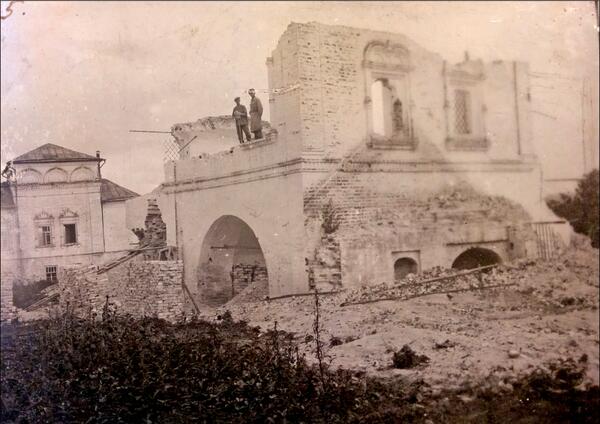In 1643, on the site of the fortress, according to the charter of Tsar Mikhail Fyodorovich Romanov, the St. Nicholas Monastery was founded. It remained wooden until the last quarter of the 17th century. The Gorokhovets merchant Semyon Nikiforovich Yershov funded the construction of the stone Holy Trinity-St. Nicholas Church between 1686 and 1689.
In subsequent years, until the mid-18th century, the territory of the monastery was actively developed. The Gate Church of the Intercession of the Most Holy Mother of God was built in 1689 at the expense of the Gorokhovets merchant Grigory Avdeyevich Shiryayev, who also was a township elder at the time. Three stone churches were built in Gorokhovets through the efforts of his brother, the merchant Ivan Shiryayev.
In the records of 1764, the church was listed as a structure with one altar and one dome. They also mentioned one-story cells that adjoined the church from the north and the south. The antechurch entrance was decorated with a large ancient fresco depicting the Laudation of the Mother of God — the Orthodox feast that honors the deliverance of Constantinople from an enemy invasion. An iconostasis gilded in the Petrine era was placed inside the Gate Church.
For two centuries, the Church of the Intercession of the Most Holy Mother of God remained unchanged, even its wooden roof. The church was restored at the expense of a local philanthropist only in 1893. Under the Soviet regime, between 1922 and 1923, the St. Nicholas Monastery was closed, and monks and novices had to leave the monastery. In the 1930s, the church was dismantled for good.
The first exploration works at the site of the destroyed Gate Church of the Intercession were organized in 1991 by the archaeologist Viktor Petrovich Glazov. In 2017, several exploratory shafts were constructed to locate the passage gates.
In one of those vertical shafts, at a depth of 0.5–0.9 meters from the level of the daylight surface, a corner of a brick structure was cleared. The researchers identified it as the northeast corner of the northern monastery cell. Their most remarkable find was a fragment of a large limestone cross with a relief image of a crucifix.
In subsequent years, until the mid-18th century, the territory of the monastery was actively developed. The Gate Church of the Intercession of the Most Holy Mother of God was built in 1689 at the expense of the Gorokhovets merchant Grigory Avdeyevich Shiryayev, who also was a township elder at the time. Three stone churches were built in Gorokhovets through the efforts of his brother, the merchant Ivan Shiryayev.
In the records of 1764, the church was listed as a structure with one altar and one dome. They also mentioned one-story cells that adjoined the church from the north and the south. The antechurch entrance was decorated with a large ancient fresco depicting the Laudation of the Mother of God — the Orthodox feast that honors the deliverance of Constantinople from an enemy invasion. An iconostasis gilded in the Petrine era was placed inside the Gate Church.
For two centuries, the Church of the Intercession of the Most Holy Mother of God remained unchanged, even its wooden roof. The church was restored at the expense of a local philanthropist only in 1893. Under the Soviet regime, between 1922 and 1923, the St. Nicholas Monastery was closed, and monks and novices had to leave the monastery. In the 1930s, the church was dismantled for good.
The first exploration works at the site of the destroyed Gate Church of the Intercession were organized in 1991 by the archaeologist Viktor Petrovich Glazov. In 2017, several exploratory shafts were constructed to locate the passage gates.
In one of those vertical shafts, at a depth of 0.5–0.9 meters from the level of the daylight surface, a corner of a brick structure was cleared. The researchers identified it as the northeast corner of the northern monastery cell. Their most remarkable find was a fragment of a large limestone cross with a relief image of a crucifix.




